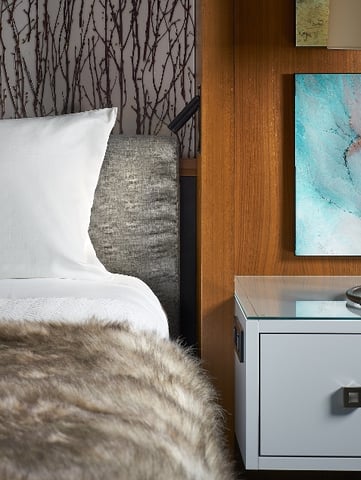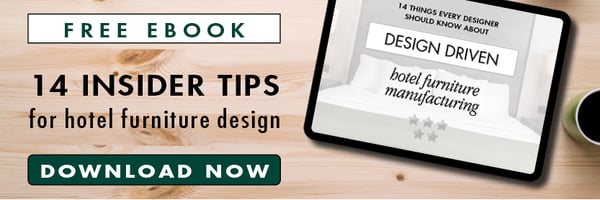(Editor’s note: This article on hotel interior design ideas is a collaboration between Dahlstrom Metal Mouldings and Artone LLC.)
Your hotel might offer the greatest hotel experience in the world. Amazing service staff. To-die-for food. And beds your guests have an easy time falling asleep in at the end of a busy day.
But a run-down, beat-up aesthetic can permanently affix a negative perception in your guest’s mind. It’s like serving a beautiful, prime cut of Wagyu steak with all the accoutrements on a garbage can lid – it doesn’t matter how good that steak is, it’s all about the perception.
Unfortunately – or fortunately – optics are (almost) everything in the hotel business, and the busiest areas of a facility are usually the ones guests encounter first. As you know, the busier a space is (say, a lobby) the more it needs furnishings that can stand up the rigors of everyday use.
Having pieces that are durable doesn’t mean relagating your hotel design ideas to drab, clunky, and cumbersome
Keep reading as we put high-traffic areas under the microscope and identify hotel interior design ideas that’ll keep your work looking beautiful for ages.
While this article is purposed for hotel interior design, you can also borrow these ideas for airports and other commercial spaces. You see a lot of stainless steel in airports these days, but it has no decorative quality – It’s just a flat piece with no design intent.
You’ll see below that durability and beauty don’t have to be mutually exclusive!
Why Hotel Interior Design Ideas Should Account for Durability (+ 4 Places Where it Matters Most)
Any successful hotel has 100s, if not 1,000s, of occupants passing through its doors each week. Failure to account for unavoidable wear and tear in your design is like throwing money off the 33rd-floor balcony.
Here are some of the areas in high-traffic spaces that your hotel interior design ideas should 110% consider durability – especially for casegoods.
-
Hotel lobbies
-
Hotel corridors
-
Hotel breakfast areas
-
Guest rooms
Hotel Lobbies
The hotel lobby is the first thing new arrivals see. It should look the same quality-wise on Day 10,000 as it did on Day 1.
Durable hotel architecture and furnishings can receive scuffs, scrapes, and dents from:
-
Floor buffing or vacuuming machines
-
Crowded foot traffic
-
Suitcases
The modern hotel lobby is definitely worth the long-term investment in high-end materials.
Hotel Corridors
Architects will tell you that most hotels renovate their corridors once every three years. If this seems like a monumental waste of money and time, that’s because it probably is.
Hotel corridor design is fraught with risk for damages, especially when hallways are narrow.
Why?
That’s simple – there’s a limited amount of clearance available. Narrow hotel corridor width causes lots of bumps and bruises for your base trim, coming from:
-
Shoes and boots
-
Suitcases
-
Housekeeping and hospitality carts
-
Vacuum cleaners
Hotel Breakfast Areas
Any place where large numbers of people congregate at once is at risk for interior damage and general grunge. In a hotel breakfast area, that damage may come from:
-
Foottraffic
-
Floor buffing machines
-
Chairs and tables being moved
-
Food spills
Guest Rooms
Your guests want to be treated like VIPs, even if they’re staying in a “standard” room. A clean, fresh presentation is important and will lead to repeat business.
The type of wear and tear you can expect in your guestroom may depend on your hotel’s location and guest demographic. Typical guest room damage occurs from:
-
Cleaning products & tools
-
Environmental conditions (exposure to moisture, heat, etc.)
-
Normal guest wear & tear
-
Movement of furniture
Hotel Interior Design Ideas The Beat the Traffic
Upkeep on areas that see rugged use may seem like a lost cause. But these days, hotel furniture manufacturers have some extra-resistant tricks up their sleeves for avoiding scratches and scuffs.
1. Metal Mouldings
In just about every test, metal proves to be the most durable architectural moulding. Think of the advantage you gain by placing metal trim in high-traffic rooms of your hotel, or the very doors themselves.
The metal moulding outclasses wood and vinyl counterparts in several days:
-
Does not catch fire
-
No rotting
-
No pest infestations
-
Easier to clean -- just wipe them with mild detergent and dry them with a towel
-
Does not split like wood
-
Much easier to replace than vinyl
-
Far superior corrosion resistance -- 100s or even 1,000s of years of life!
A little more about the highest-quality mouldings you can use in your interior hotel design:
-
Stainless steel is the most resistant metal architectural moulding because it has a high yield strength and is harder than other architectural metals. This resilience applies whether you’re talking about denting, scraping, or corrosion. Also, cleaning stainless steel mouldings is especially easy.
-
Brass and bronze are on the softer end, but thanks to their inclusion of alloying metals like zinc, they’re a little stronger than copper. You can also allow brass and bronze, along with copper, to intentionally corrode to achieve a stately patina effect (without flaking or corrosion).
-
Copper is the least resilient of the four metals we’ve listed. However, copper comes in numerous grades, so using certain high-durability types can minimize this drawback. We at Dahlstrom tend to use middle-of-the-road copper because it provides solid durability while remaining easy enough to form into our 1,600+ moulding shapes. Plus, where else can you get that beautiful, reddish hue?
Think about turning to metal’s combination of elegance and sturdiness in your next hotel corridor design.
2. More Durable Furniture Surfaces & Corners
Make sure your custom hotel furniture manufacturer uses Architectural Woodwork Institute (AWI)-approved materials and manufacturing processes. AWI’s function is to standardize the methods in which furniture and millwork is manufactured, therefore ensuring quality.
 What was the construction method? What hardwood (or other material) was used? What finish was applied? How durable is the design? These are all questions the AWI asks -- and for which your manufacturer should have an answer.
What was the construction method? What hardwood (or other material) was used? What finish was applied? How durable is the design? These are all questions the AWI asks -- and for which your manufacturer should have an answer.
There are surfaces all over hotel rooms that are begging for an upgrade:
-
Nightstands
-
Desks
-
Dressers
-
Sitting table
-
Backboards to mounted TVs
-
Headboards
What about outside the guest room?
Maybe there’s a horizontal surface in your hotel’s common area that could be upgraded to quartz. Start with your most scratch-prone furniture: Writing surfaces, breakfast area surfaces, reception counter surfaces, and so on.
To protect against corner damage to your casegoods, your hotel furniture manufacturer and designer can add a touch of metal. You can request accents to the:
-
Dressers
-
Nightstands
-
Practically anywhere else you want!
These are protective features that double as attractive embellishments. A rigid vinyl edge and especially an edging or tube steel will look great while surviving dings from vacuum cleaners and the like.
Remember: A more expensive surface material, or that extra touch of metal, is going to buy you extra years on your furniture’s life.
A Stronger Finish

Hotel furniture makers have several go-tos for furniture surface finishes, including:
-
Veneer
-
Laminate
-
Solid wood
Of the three options, we find that laminate is the most cost-effective option that still maintains durability.
Laminate itself is further divided into two categories: HP laminate and LP laminate.
-
HP laminate (aka high-pressure laminate) is very durable, making it ideal for horizontal surfaces. It’s quite rigid and therefore can withstand the impact of, say, someone slamming down a cocktail glass.
-
LP laminate (aka low-pressure laminate). The only difference is that it’s used on vertical surfaces, which typically sustain less routine impact. You still get the same finish and look as its HP big brother.
In the case of metal mouldings, a pre-painted finish is far more durable than anything that’s painted on with a brush. When you paint with a brush, the solvents air dry and leave you with the pigments in the paint.
A baked-on finish, or, alternatively, a powder coating finish, undergoes “crosslinking,” where the heat creates a homogenous surface. It’s not reversible, and therefore it’s impressively durable.
Furniture for a Lifetime
Yes, custom or metal architectural materials can cost more. But doesn’t it make sense to build something that’ll last, instead of something you’ll need to replace in a few years? Designing the right way the first time is far more cost-effective than a Band-Aid approach.
Furniture has changing styles -- but metal always looks up to date and modern. So using more innovative materials for interior design gives you longevity in style, too.
Consult with a custom manufacturer to help you get the most out of your hospitality design and materials.
(Dahlstrom Metal Mouldings has been the premier supplier of decorative architectural metal mouldings, casings, chair rails, and accent trim for over 100 years. Dahlstrom’s vast array of shapes cannot be found anywhere else in the world and has been used by architects on the Rockefeller Center, U.S. Bank Stadium, and many other famous buildings.)
This article was originally published in 2019 and was updated to reflect industry trends.

